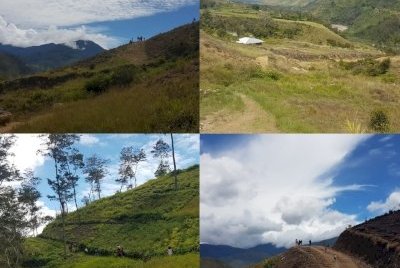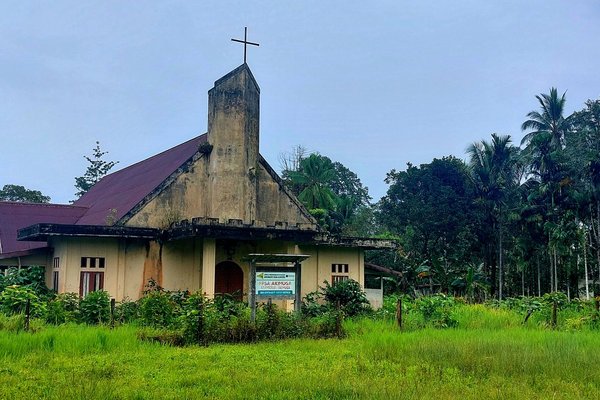Indonesia
Lorentz National Park
Lorentz National Park is an outstanding example of the biodiversity of New Guinea, and one of the most ecologically diverse national parks in the world.
This very large park is located where the Australian and Pacific tectonic plates collide. It contains a full altitudinal array of ecosystems spanning marine areas, mangrove, tidal and freshwater swamp forests, lowland and montane rainforests, alpine areas, and equatorial glaciers. Puncak Jaya (4884m) is the tallest mountain between the Himalayas and the Andes. The endangered Dingiso tree kangaroo is found here, as well as short-beaked echidna, long-beaked echidna and two threatened species of crocodiles.
Community Perspective: Zoë tried to get grips on the park using Wamena as a base. Lake Habbema (a birders' favourite) is the only part that is accessible by road, according to the IUCN evaluation. It is also possible to fly with Asian One Air from Timika to Akimuga, which lies in the core zone but provides no infrastructure to explore the natural surroundings.
Site Info
Official Information
- Full Name
- Lorentz National Park (ID: 955)
- Country
- Indonesia
- Status
-
Inscribed 1999
Site history
History of Lorentz National Park
- 1999: Inscribed
- Inscribed
- Type
- Natural
- Criteria
- viii
- ix
- x
Links
- UNESCO
- whc.unesco.org
- Official
-
- tamannasionallorentz.menlhk.go.id — Taman Nasional Lorentz
- Related
-
- v2.garudamagazine.com — The Wonders of Wamena
All Links
UNESCO.org
- whc.unesco.org — whc.unesco.org/
Official Website
- tamannasionallorentz.menlhk.go.id — Taman Nasional Lorentz
Related Resources
- v2.garudamagazine.com — The Wonders of Wamena
Community Information
- Community Category
- Natural landscape: Diverse ecosystems
Travel Information
One thousand visitors or fewer
Recent Connections
-
Oceanic Dolphins
"The Marine Protection Zone (1.76%), lo…
-
Perfect Inscriptions
1999 -
Over 100 mammal species
"Some 123 mammals have been recorded fr…
Connections of Lorentz National Park
- Geography
-
-
Disputed territories
Lies in West-PapuaSee en.wikipedia.org
-
Territorial Highest points
Puncak Jaya 488m/16024ft -
Melanesia
-
Glaciers
Meren and Carstenz glaciers and a small hanging glacier on the Carstenz Pyramid -
World's Highest Topographically isolated summits
Puncak Jaya 5th most isolated (5261/4884) -
World's most prominent mountains
Puncak Jaya 9th most prominent (5884m/0/MSL)
-
- Trivia
-
-
Greatest Altitude Variations
Sea Level - 4884m : 4884m difference -
Google Doodles
Dec 4, 2019: "celebrates the anniversary of Indonesia’s Lorentz National Park"See www.google.com
-
- Ecology
-
-
Cloud forest
The mid-montane zone which is known as cloud or mossy forest, is dominated by Nothofagus species and starts about 1,500m (UNEP-WCMC) -
Turtles and tortoises
the rare pig-nosed turtle (UNEP-WCMC)
-
Mangroves
-
Beech Forests
Nothofagus beech forests -
Rainforests
-
Crocodiles
-
Critically endangered fauna species
Western Long-beaked Echidna (Zaglossus bruijni) - "has not been recorded since the 1980s" in the park -
Ratites
southern cassowary -
Peat
freshwater peat swamps (UNEP-WCMC) -
Significant Karst Features
World's best example of tropical alpine glaciated karst (AB ev) -
High-Biodiversity Wilderness Area
New Guinea, Indonesia and Papua New Guinea -
Tidal effects
tidal swamps (Coastal WHS) -
Swamps and Marshes
"The park ... has a large number of streams and rivers which have cut deep valleys in the mountains and foothills as they drain south to the coastal plain. Here they form extensive areas of swamps with numerous permanent and seasonal lakes" (AB ev) -
Refugium
"Criterion (x): The mountain building processes that have occurred over time have provided temperate refuges in the tropics for ancient Gondwanan plant species during the climatic warming that has occurred since the last ice age. For example, Lorentz National Park’s Nothofagus beech forests are well represented, although their closest relatives are otherwise confined to the cool temperate regions of south-eastern Australia, New Zealand and the southern Andes." (OUV) -
Over 300 bird species
"the avifauna is likewise extremely rich, with 411 species recorded, including at least 20 species endemic to Irian Jaya. Notable species include 2 species of cassowary, 4 megapodes, 30 parrots, 20 birds-of paradise and 6 species of bowerbirds" (AB). -
Over 100 mammal species
"Some 123 mammals have been recorded from the reserve, representing 80% of the total mammalian fauna of Irian Jaya." (IUCN ev) -
Oceanic Dolphins
"The Marine Protection Zone (1.76%), located in the Arafura Sea, safeguards key aquatic species like sawfish, dolphins..." (IUCN Outlook 2025) - possibly Indo-Pacific bottlenose, Australian humpback dolphin, and the spinner dolphin (as they are seen in the Arafura Sea)
-
- Damaged
-
-
'Threatened' by Roads
Habema-Kenyam road
-
- World Heritage Process
-
-
Perfect Inscriptions
1999
-
- Human Activity
-
-
Natural sites with indigenous human population
The forests of Lorentz encompass the traditional lands of several ethnic groups, including the Asmat, Amungme, Dani, Sempan, and Nduga. -
Language isolate
Damal (Amung/Uhunduni)- According to the nomination dossier, the Damal tribe inhabits the highlands of the park. Damal is proposed as a part of Trans-Papua, but this affiliation has been rejected by Glottolog due to lack of evidence.
-
- WHS on Other Lists
-
-
World Heritage Forest Programme
-
Centres of Plant Diversity
SEA69 Gunung Lorentz - "evidence of highly developed endemism in both plants and animals, especially for the higher altitudes of the mountains" -
ASEAN Heritage Parks
-
Located in a TCC Territory
Papua
-
- Timeline
-
-
Late Pleistocene
The lowering and rising of the sea level during the glacial and inter-glacial periods of the Pleistocene, along with continuous activity in the mobile belt which characterizes the contact zone of the two colliding lithospheric plates, has continued to promote the great biodiversity of the island of New Guinea in general, and in the Lorentz area in particular. (EOEarth)
-
- Visiting conditions
-
-
One thousand visitors or fewer
“Owing to difficulties with security and access and lack of facilities, tourists totalled less than 100 in 1998.”See www.ancient.eu
-
- WHS Names
-
-
Named after individual people
Hendrikus Albertus Lorentz, a Dutch explorer who passed through the area on his 1909-1910 expedition.
-
News
No news.
Community Reviews
Show full reviews
Took me years to accomplish visiting and even then it wasn't easygoing though it should have been rather simple. First off while you see the park on Google Map that isn't really where the park starts and ends. The inscription file has a map and it's different again so eventually I gave up trying to figure out where the park is really. One forum online quoted "the park only exists on paper" and it's really just nature that keeps going and going. If you look at Google you will find no real towns in the park either. Trying to enter from Timika was an idea but again there is nothing touristy from there. Then I stumbled across Wamena in the highlands. It's beyond the mountains and outside the world heritage site but it's in my opinion the only way to reach the park.
Flying into Wamena is quite easy as there are daily flights from Jayapura and that is connected well with Sorong and beyond. I took an overnight flight from Bali via Makassar and another town before connecting with the flight to Wamena. You don't really want to stay in Jayapura if you can avoid it.
Wamena is quite small but has hotels and restaurants to make you feel comfortable enough. Most people that come here are trekkers. Don't expect a fancy trip. You don't need to arrange a permit to visit the area even though it says with many online sources but the hotel assured me …
Keep reading 0 comments
